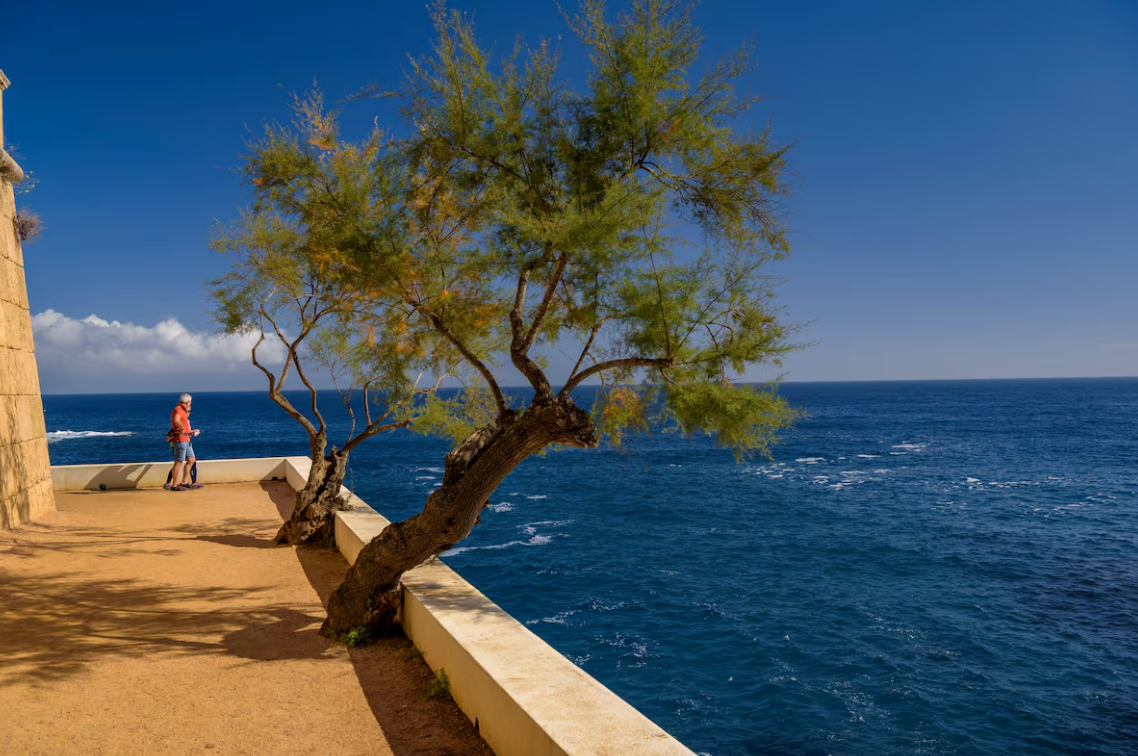The Costa Brava, one of Catalonia’s most picturesque coastlines, is home to a network of camins de ronda—historic coastal paths once used by fishermen and anti-smuggling patrols. Today, they attract hikers eager to explore breathtaking Mediterranean scenery, secluded coves, and cultural treasures. Martí Sabrià, a key figure in promoting tourism and heritage in the region, recommends nine routes through L’Empordà, a historic Catalan region where rugged cliffs, pine forests, ancient ruins, and gourmet experiences await.
1. A Scenic Start — S’Agaró to Sa Conca (2 km)
Celebrating its centenary in 2024, the S’Agaró urbanization is a landmark of Costa Brava’s architectural history. Designed by Francesc Folguera, this elegant coastal path features wide promenades, gentle staircases, and views framed by tamarind and pine trees. Starting at Hostal La Gavina, the Costa Brava’s first five-star hotel (opened in 1932), the walk showcases Mediterranean-style villas and a loggia overlooking the sea. The route ends at Sa Conca, a stunning sandy beach perfect for a springtime sunbath.
2. Red Rocks and Hidden Coves — Cala d’en Rovira to Ses Torretes (1.5 km)
This short but dramatic hike reveals some of Girona’s most photogenic coves. From Sa Cova, with its pine canopy and fishing boats, to Cala del Pi and the striking Cap Roig islet, hikers are rewarded with postcard-worthy views. The red tones of the rocks, caused by feldspar, contrast beautifully with the turquoise waters. A refreshing stop at the Cala Gogo terrace completes the experience.
3. Fishing Heritage — La Fosca to Castell (1.7 km)
The path begins at La Fosca beach, named after a dark offshore rock formation, and passes the ruins of Sant Esteve Castle, Palamós’s medieval origin. Descending through pine groves, you’ll reach S’Alguer, a picture-perfect fishing hamlet with colorful boat sheds designed to be distinguishable from the sea. The route ends at Castell Beach, a rare gem preserved from development thanks to a local referendum in 1994.
4. Wild Beauty — Tamariu to Cala Pedrosa (1.5 km)
This route offers untouched coastal scenery. After passing the secluded Cala dels Liris, you’ll walk through pine-scented trails once owned by British aristocrat Lord Islington. A wooden fence ensures safe access to Cala Pedrosa, where snorkelers and swimmers can explore its clear waters. This hike is a reminder of Costa Brava’s untamed charm.
5. A Gourmet Pilgrimage — Rostella to Murtra (2 km)
Located within the Cap de Creus Natural Park, this rugged coastal trail leads to Cala Montjoi, home to elBulli1846, the world’s first restaurant-turned-museum created by Ferran Adrià. Visitors can combine hiking with cultural exploration, learning about Adrià’s groundbreaking culinary work. Along the way, Murtra Cove offers a tranquil, clothing-optional beach experience, while the dramatic headland of Cap Norfeu dominates the horizon.
6. Wine and History — Garbet to Colera Cannons (1.5 km)
The Garbet Estate is home to one of the Mediterranean’s rare cliffside vineyards, producing wines that justify their exclusivity. This hike combines vineyard views with history: passing secluded coves and the islands Petita and Gran, you’ll eventually climb to the Colera Cannons, remnants of Napoleonic-era defenses. It’s a unique blend of wine tourism and adventure.
7. In Josep Pla’s Footsteps — Calella de Palafrugell to Llafranc (1.5 km)
This charming route connects two iconic fishing villages. Starting at Les Voltes del Port Bo, the path takes you past the summer house of Josep Pla, Catalonia’s beloved writer, who immortalized these landscapes in his works. Along the way, scenic viewpoints honor photographer Xavier Miserachs and journalist Carlos Sentís. The journey concludes at Llafranc, where the Michelin-starred Casamar restaurant offers refined cuisine.
8. A Walk Through History — Rec to Sant Martí d’Empúries (1.8 km)
This trail blends beach scenery with ancient history. Starting near L’Escala, walkers encounter the Portitxol arch and Empúries archaeological site, once a Greek and Roman settlement dating back to the 6th century BCE. The highlight is the Moll Grec (Greek Pier), a perfectly preserved ancient harbor structure. The route ends in Sant Martí d’Empúries, a charming medieval village with cobbled streets and inviting restaurants.
9. A Necklace of Coves — Sa Tuna to Aiguafreda (1.2 km)
From the quaint fishing cove of Sa Tuna, this path offers dramatic sea views and a look at Hotel Cap Sa Sal, built in the 1960s by Dr. Andreu of Juanola fame. The trail hugs the rugged cliffs, passing Cala S’Eixugador and leading to Aiguafreda, a secluded bay perfect for paddleboarding or snorkeling. Stay or dine at the Hostal Sa Tuna, a local favorite.
A Coastal Paradise for All Seasons
The Empordà’s camins de ronda are more than hiking routes—they’re a cultural and sensory experience. Each path reveals a different facet of Costa Brava: from architectural gems in S’Agaró to wild pine forests, from ancient Greek ruins to world-class dining. Whether you’re drawn by its beaches, art, or history, these trails offer something for everyone.
Spring and autumn are ideal for exploring, avoiding the summer crowds and enjoying mild weather. Comfortable shoes, a swimsuit, and a camera are all you need to make the most of this Mediterranean treasure.
With its blend of history, gastronomy, and natural beauty, Empordà is proof that the best way to experience Costa Brava is on foot—one scenic step at a time.
